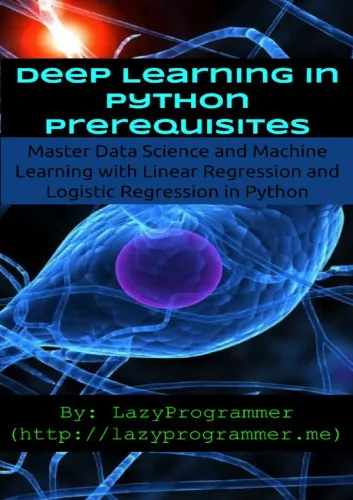Deep Learning in Python Prerequisites: Master Data Science and Machine Learning with Linear Regression and Logistic Regression in Python (Machine Learning in Python)
4.5
Reviews from our users

You Can Ask your questions from this book's AI after Login
Each download or ask from book AI costs 2 points. To earn more free points, please visit the Points Guide Page and complete some valuable actions.Introduction to 'Deep Learning in Python Prerequisites'
Welcome to 'Deep Learning in Python Prerequisites: Master Data Science and Machine Learning with Linear Regression and Logistic Regression in Python', a book tailored for aspiring data scientists and machine learning enthusiasts seeking a firm foundation in essential concepts before diving into more complex realms of deep learning. This book provides a clear, methodical approach to understanding crucial statistical models, coding practices, and techniques that form the backbone of applied machine learning. Whether you’re transitioning into a career in data science or simply looking to sharpen your skills, this book offers all the prerequisites you need to succeed.
Detailed Summary of the Book
This book is designed to take you by the hand and guide you through the critical fundamentals of machine learning. It starts with an in-depth exploration of Linear Regression, one of the simplest yet most powerful tools for predicting continuous values. From understanding the mathematical underpinnings to implementing it in Python with libraries like NumPy and scikit-learn, you’ll gain hands-on experience every step of the way.
Next, the book transitions to Logistic Regression, which is a cornerstone algorithm for classification problems. You’ll learn how to apply logistic regression to real-world datasets, interpret its output, and assess its performance using techniques such as confusion matrices, accuracy, precision, and recall.
Both regression techniques are explained thoroughly, ensuring no stone is left unturned when it comes to key concepts like gradient descent, cost functions, and maximum likelihood estimation. The book also highlights the importance of feature scaling, one-hot encoding, and data preprocessing—skills critical for preparing any dataset for machine learning models.
By the time you finish this book, you’ll not only possess the technical skills but also the contextual understanding required to grasp advanced deep learning techniques. It ensures a smoother transition into topics such as neural networks, convolutional neural networks (CNNs), and recurrent neural networks (RNNs), which are explored in sequel works and tutorials.
Key Takeaways
- Master the basics of Linear Regression, from theory to implementation in Python.
- Learn how Logistic Regression enables classification tasks with high accuracy.
- Understand essential concepts like gradient descent and cost functions to optimize models.
- Gain proficiency in using Python libraries like NumPy, Pandas, and scikit-learn.
- Develop best practices for data preprocessing, including feature scaling and encoding techniques.
- Build confidence in applying statistical machine learning models to real-world problems.
Famous Quotes from the Book
"You don’t need to master deep learning to become proficient in machine learning, but mastering the fundamentals ensures your deep learning journey is seamless."
"Linear regression may seem simple, but its applications span industries and fuel the backbone of predictive analytics."
"The ability to interpret logistic regression results is what separates a good data scientist from a great one."
Why This Book Matters
In the ever-evolving world of data science and machine learning, a solid grasp of foundational concepts is essential. This book stands out because it doesn't just teach you how to code machine learning models; it equips you with the why behind each concept. In doing so, it bridges the gap between theory and practical application.
Many courses and books jump straight into deep learning, glossing over the prerequisites that are crucial for understanding complex neural networks and architectures. This book fills that gap, preparing you for the next step without overwhelming you.
By focusing on linear regression and logistic regression, two of the most widely used algorithms in the field, this book acts as a launchpad for diving into advanced areas like artificial intelligence, natural language processing, and image recognition. These algorithms have real-world applications in fields such as finance, healthcare, marketing, and transportation, making them indispensable for modern-day data scientists.
Whether you’re a beginner, a seasoned professional refreshing your skills, or someone aiming to master deep learning systematically, this book is a crucial step in your journey. Mastering the prerequisites means you’ll not only excel at deep learning but also become a versatile, knowledgeable practitioner of applied machine learning.
Free Direct Download
You Can Download this book after Login
Accessing books through legal platforms and public libraries not only supports the rights of authors and publishers but also contributes to the sustainability of reading culture. Before downloading, please take a moment to consider these options.
Find this book on other platforms:
WorldCat helps you find books in libraries worldwide.
See ratings, reviews, and discussions on Goodreads.
Find and buy rare or used books on AbeBooks.


